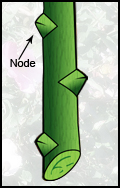Maybe you haven’t considered cloning your favorite plant, but many garden plants including those sold in warehouse nurseries are clones!
Cloning is a simple vegetative method for obtaining exact genetic duplicates of existing plants. Most commonly used for large-scale propagation, it’s also an easy way to take plants with you when you move or to scale them down for winter storage.
Success depends on several factors. Some plants such as coleus, hibiscus and roses can be rooted very easily when cuttings are placed in a growing medium. Others, particularly woody plants, will need the help of a root stimulator or rooting hormone.
For successful cloning, you need:
|
 |
Roots begin to develop in one to four weeks, first appearing as fine, white strands. After a month, your cuttings should be ready to transfer. Good luck!




